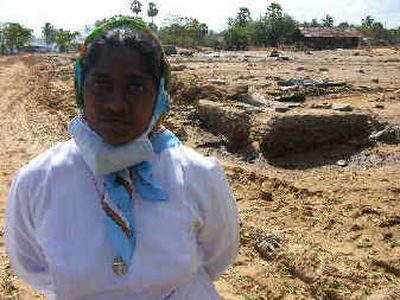No strangers to tragedy

MULLAITTIVU, Sri Lanka – On a spit of land along the northeast coast of Sri Lanka, this town is slowly being burned to the ground.
With its main street only 300 hundred yards from the water’s edge, the Boxing Day tsunami turned this fishing town into a wasteland. Too much debris and too few backhoes mean that anything combustible is set afire at dusk.
Amid the rubble and smoke I meet Sister Hilda of the Holy Family of Bordeaux. The headmistress of a local elementary school, she is working ahead of the flames to salvage wood and brick to rebuild her school.
“We had 500 students before Christmas break,” she says through a surgeon’s mask. “When school opens again, I expect about 250 students will be back.”
Between body counts and collapsed buildings, subtler signs tell the story of Mullaittivu’s destruction. Along the beach, the tops of 30-foot palm trees are a dead, brown color from the sea salt that washed over them. More than a mile inland, knee-high rice paddies were also swamped and have turned a similar yellow-brown. And when they heard a wave of such height and power coming ashore, the people of Mullaittivu thought they knew exactly what to do.
“They got down on the ground. They got as low as they could,” Sister Hilda says. “They could hear the wave before they could see it. Everybody inside their houses thought the town was being bombed again.”
The people of Mullaittivu are tragically habituated to destruction. Structures spared by the tsunami are pockmarked with bullet holes from a 20-year civil war between the Sri Lankan government and the Liberation Tigers of Tamil Eelam (LTTE).
In 1990 government forces captured the town. When the LTTE won it back in 1996, the government began a campaign of regular aerial bombardment, and the citizens fled. A 2002 cease-fire meant that war refugees had slowly begun to return home.
Today, the remaining buildings in this ghost town are under LTTE control. But at the moment, the rebel force is occupied with providing food, water and shelter for the district’s 30,000 displaced people. Fifteen miles inland, a block of 10 well-administered refugee camps are a model of what the LTTE and the government of Sri Lanka can accomplish when they work together.
But problems and politics still exist. V. Sivanadiyar, an official with the LTTE’s emergency task force, is adamant that the government allow aid to flow directly to the North and East. “If all the aid is routed through the government we will never get enough,” he says.
But with the aid that has arrived, the Tamil Tigers are proving to be efficient humanitarians. Even as Mullaittivu smolders, the emergency task force has procured 1,800 temporary tents and plans to begin resettling refugees along the coastline within the next 20 days.
But are the refugees ready to go home?
“At the moment we are dealing with a lot of people who are deeply afraid of the sea,” says Daya Somsundaram, professor of psychiatric medicine at the University of Jaffna.
Somsundaram, who has worked extensively with women and children affected by Sri Lanka’s civil war, created a Mental Health Task Force to deal with psycho-social trauma in the wake of the tsunami. “Right now we are performing ‘psychological first aid’: directing the dazed and confused, finding out information about family members and identifying bodies so that burial rituals can be carried out.”
Composed of clergy, social workers and international NGO staff, the Mental Health Task Force has reported cases of affected persons not eating, not speaking and openly contemplating suicide.
“Basically we have to reassure these people that under the circumstances their reactions are normal,” says counselor Vijay Sangar. “Only later will we be able to diagnose post-traumatic stress disorder, and begin active counseling.”
At the Vidyananda College refugee camp, the delicate process of psychological healing has already begun.
When given crayons and paper, 90 percent of the children in the camp have drawn scenes from the tsunami. The waves are a violent black and depicted as an enclosing circle. Saucer-eyed stick figures stare from treetops, and cling to the roofs of houses. Some of the bodies are headless. Some of the pages are completely black.